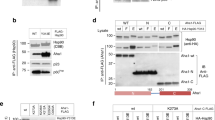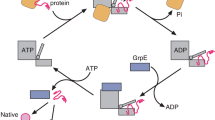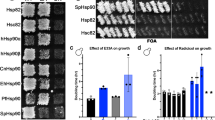Abstract
THE molecular chaperone proteins, particularly Hsp60 and Hsp70, have been implicated in essential cell functions under both normal and stress conditions (reviewed in refs 1–5). Members of the family of heat-shock proteins ofMr70K, Hsp70, bind to unfolded proteins and short peptides6–13. Addition of Mg–ATP results in the dissociation of the substrate polypeptides from the chaperone7–11, but as ATP-γS (an ATP analogue that is only slowly hydrolysable) cannot substitute for ATP in this reaction7,9,11, it has been concluded that ATP hydrolysis is necessary to dissociate Hsp70–substrate protein complexes. By independently measuring the rates of ATP hydrolysis and substrate protein dissociation, we show here that Mg–ATP binding but not Mg–ATP hydrolysis is essential for substrate dissociation. We also show that there is an absolute requirement for K+for the effect of Mg–ATP: only the combination of K+ and Mg–ATP will cause the conformational change in HspTO that is necessary for substrate dissociation. Moreover, in the absence of K+, Mg–ATP favours complex formation. We consider these results in terms of a G-protein-like model.
This is a preview of subscription content, access via your institution
Access options
Subscribe to this journal
Receive 51 print issues and online access
$199.00 per year
only $3.90 per issue
Buy this article
- Purchase on Springer Link
- Instant access to full article PDF
Prices may be subject to local taxes which are calculated during checkout
Similar content being viewed by others
References
Ellis, R. J. Seminars Cell Biol. 1, 1–9 (1991).
Hartl, F. U., Martin, J. & Neupert, W. A. Rev. Biophys. biomolec. Struct. 21, 293–322 (1992).
Gething, M.-J. & Sambrook, J. Nature 355, 33–45 (1992).
Ang, D., Liberek, K., Skowyra, D., Zylicz, M. & Georgopoulos, C. J. biol. Chem. 266, 24233–24236 (1991).
Hightower, L. E. Cell 66, 191–197 (1991).
Palleros, D. R., Reid, K. L., McCarty, J. S., Walker, G. C. & Fink, A. L. J. biol. Chem. 267, 5279–5285 (1992).
Palleros, D. R., Welch, W. J. & Fink, A. L. Proc. natn. Acad. Sci. U.S.A. 88, 5719–5723 (1991).
Beckmann, R. P., Mizzen, L. A., & Welch, w. J. Science 248, 850–854 (1990).
Flynn, G. C., Chappell, T. G. & Rothman, J. E. Science 245, 385–390 (1989).
Landry, S. J., Jordan, R., McMacken, R. & Gierasch, L. M. Nature 355, 455–457 (1992).
Liberek, K., Skowyra, D., Zylicz, M., Johnson, C. & Georgopoulos, C. J. biol. Chem. 266, 14491–14496 (1991).
Langer, T. et al. Nature 356, 683–689 (1992).
Sadis, S. & Hightower, L. E. Biochemistry 31, 9406–9412 (1992).
McCarty, J. S. & Walker, G. C. Proc. natn. Acad. Sci. U.S.A. 88, 9513–9517 (1991).
Brown, C. R., Martin, R. L., Hansen, W. J., Beckmann, R. P. & Welch, W. J. J. Cell Biol. 120, 1101–1112 (1993).
Antonino, L. C., Kautz, R. A., Nakano, T., Fox, R. O. & Fink, A. L. Proc. natn. Acad. Sci. U.S.A. 88, 7715–7718 (1991).
Bardwell, J. C. A. & Craig, E. A. Proc. natn. Acad. Sci. U.S.A. 81, 848–852 (1984).
Schmid, S. L., Braell, W. A. & Rothman, J. E. J. biol. Chem. 260, 10057–10062 (1985).
Bourne, H. R., Sanders, D. A. & McCormick, F. Nature 349, 117–127 (1991).
Liberek, K., Marszalek, J., Ang, D. & Georgopoulos, C. Proc. natn. Acad. Sci. U.S.A. 88, 2874–2878 (1991).
Author information
Authors and Affiliations
Rights and permissions
About this article
Cite this article
Palleros, D., Raid, K., Shi, L. et al. ATP-induced protein Hsp70 complex dissociation requires K+ but not ATP hydrolysis. Nature 365, 664–666 (1993). https://doi.org/10.1038/365664a0
Received:
Accepted:
Published:
Issue Date:
DOI: https://doi.org/10.1038/365664a0
This article is cited by
-
Split aptamer-based detection of adenosine triphosphate using surface enhanced Raman spectroscopy and two kinds of gold nanoparticles
Microchimica Acta (2019)
-
A disulfide-bonded DnaK dimer is maintained in an ATP-bound state
Cell Stress and Chaperones (2017)
-
In Silico Molecular Modeling and Docking Studies on Novel Mutants (E229V, H225P and D230C) of the Nucleotide-Binding Domain of Homo sapiens Hsp70
Interdisciplinary Sciences: Computational Life Sciences (2017)
-
Spectroscopic and thermodynamic properties of recombinant heat shock protein A6 from Camelus dromedarius
European Biophysics Journal (2015)
-
Visualization and functional analysis of the oligomeric states of Escherichia coli heat shock protein 70 (Hsp70/DnaK)
Cell Stress and Chaperones (2012)
Comments
By submitting a comment you agree to abide by our Terms and Community Guidelines. If you find something abusive or that does not comply with our terms or guidelines please flag it as inappropriate.



